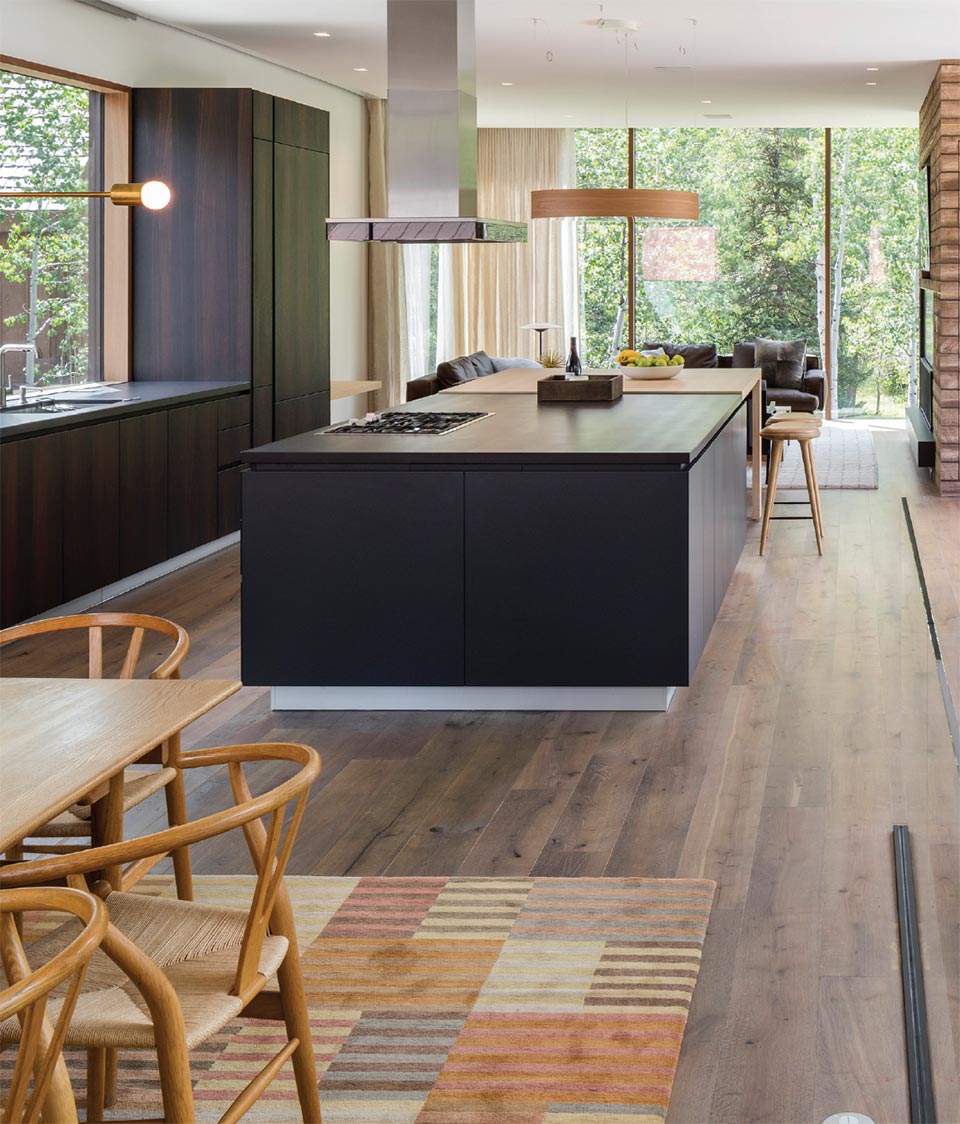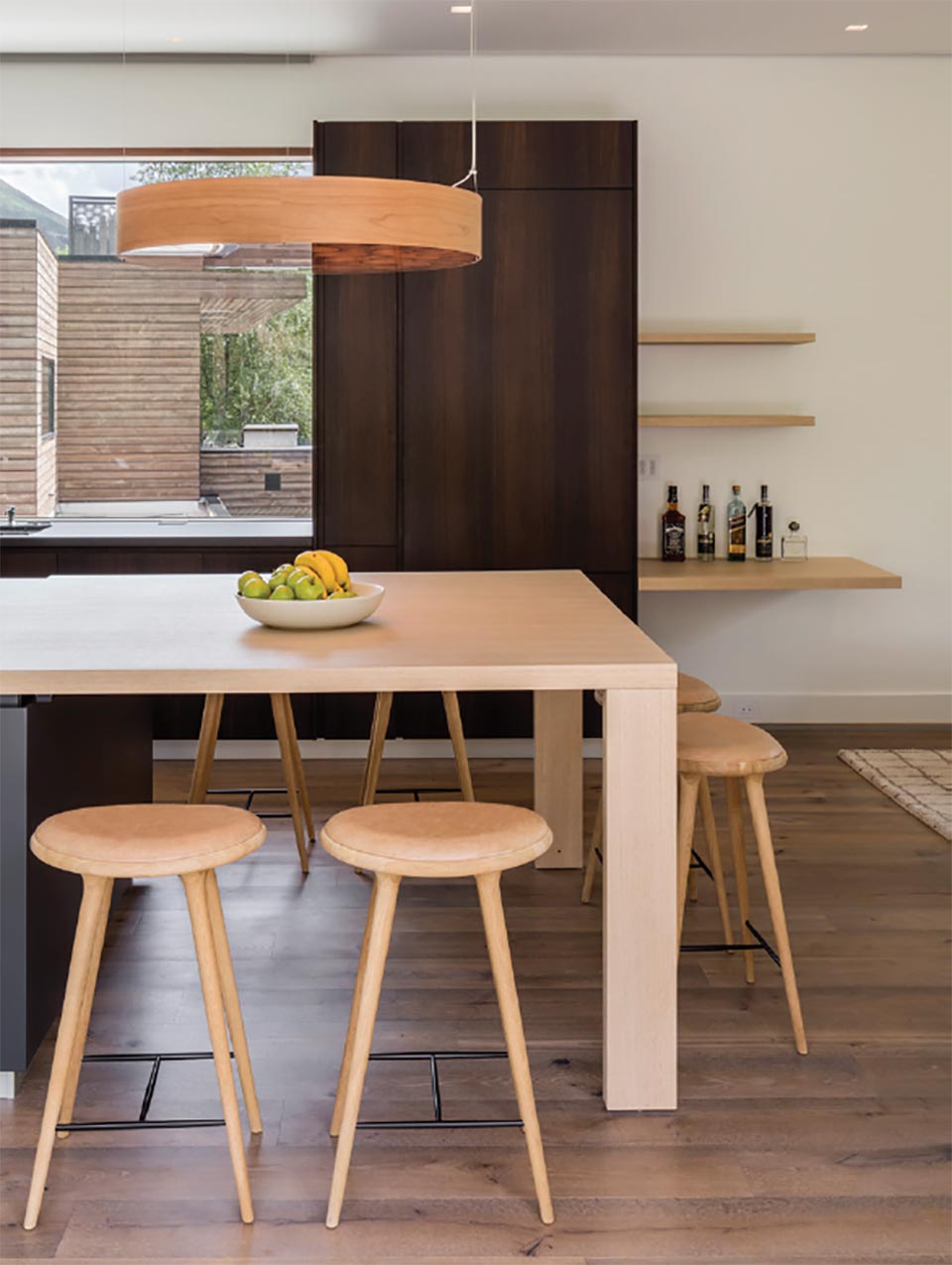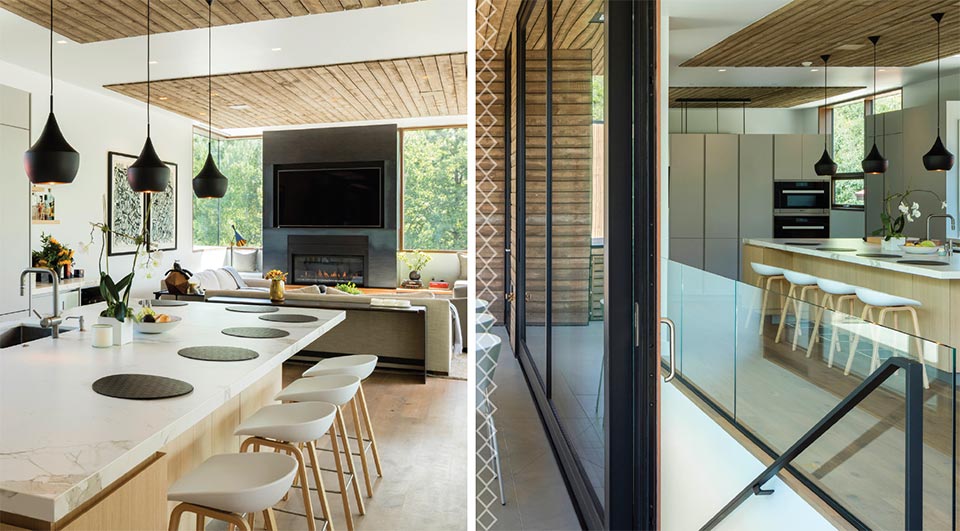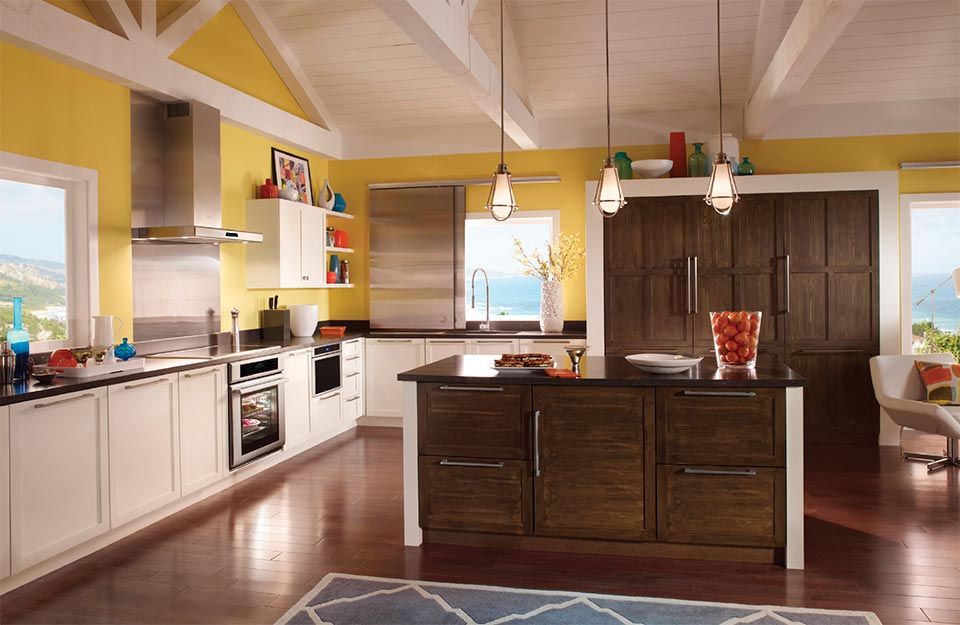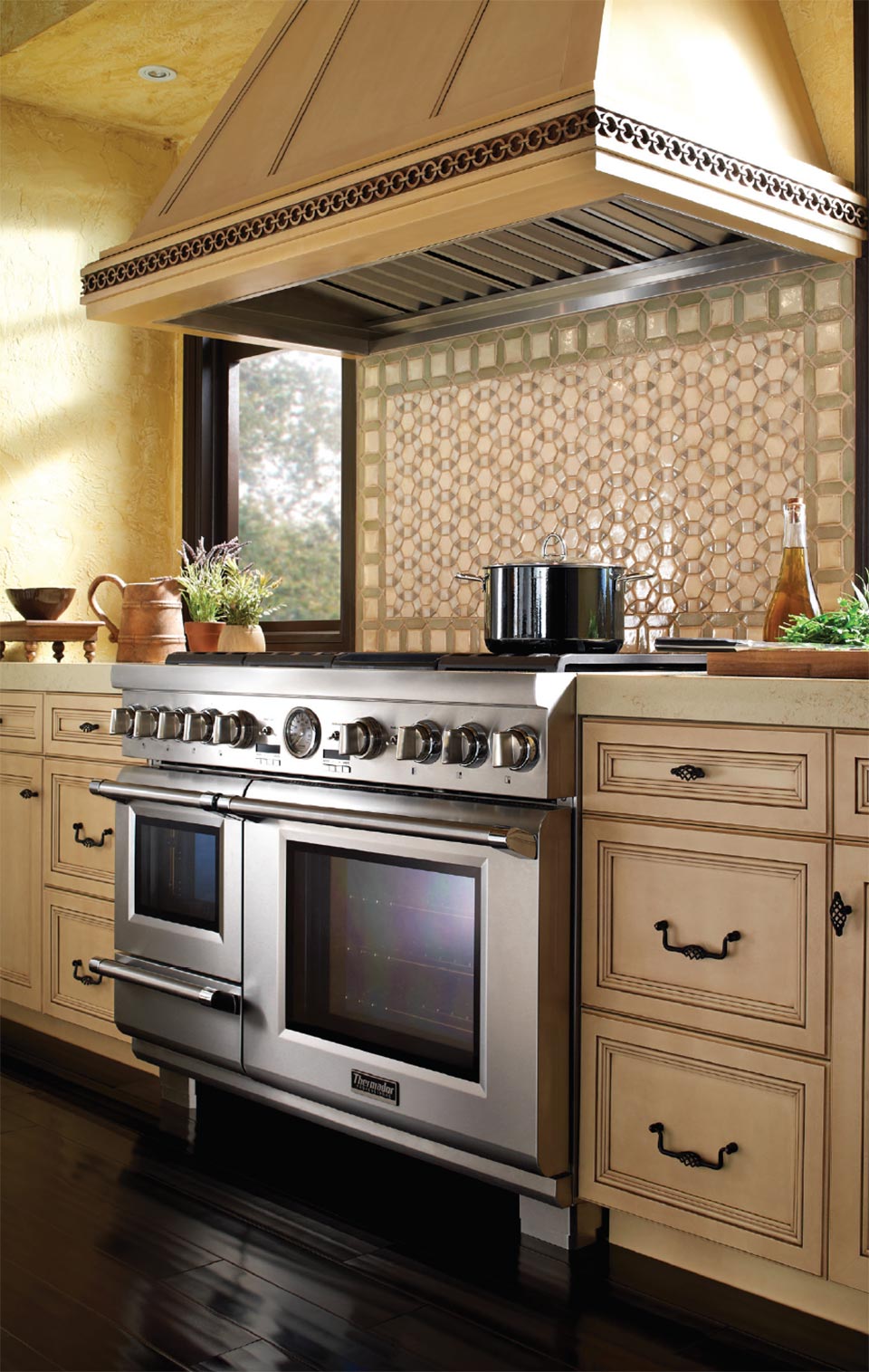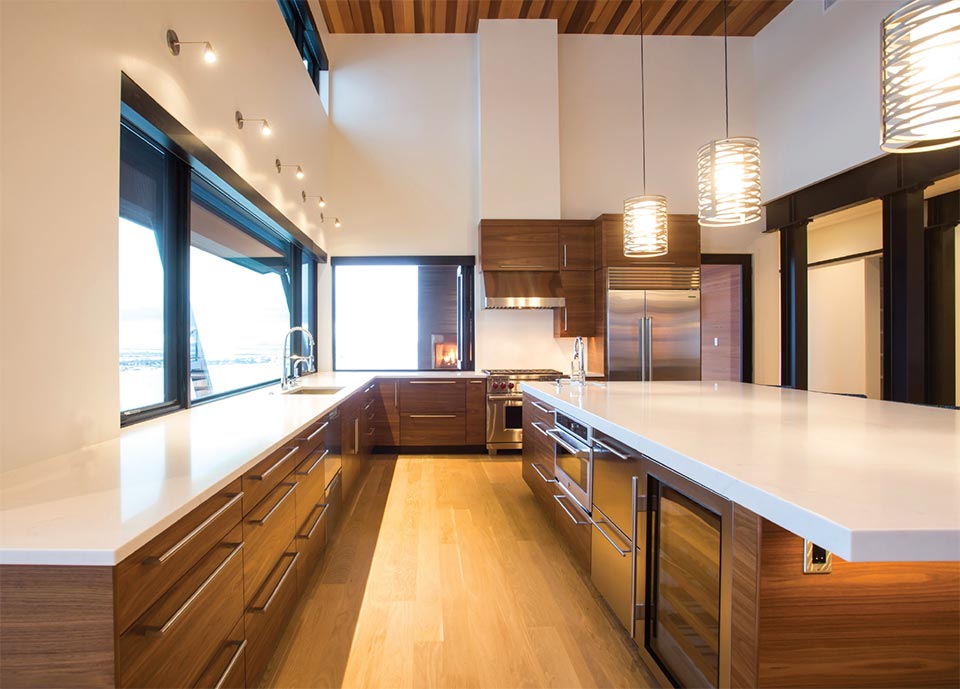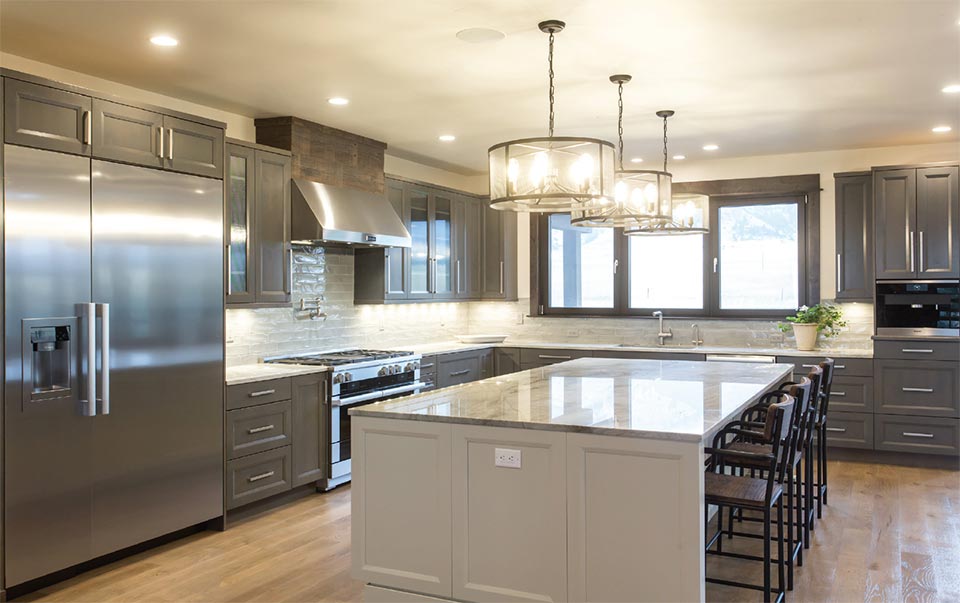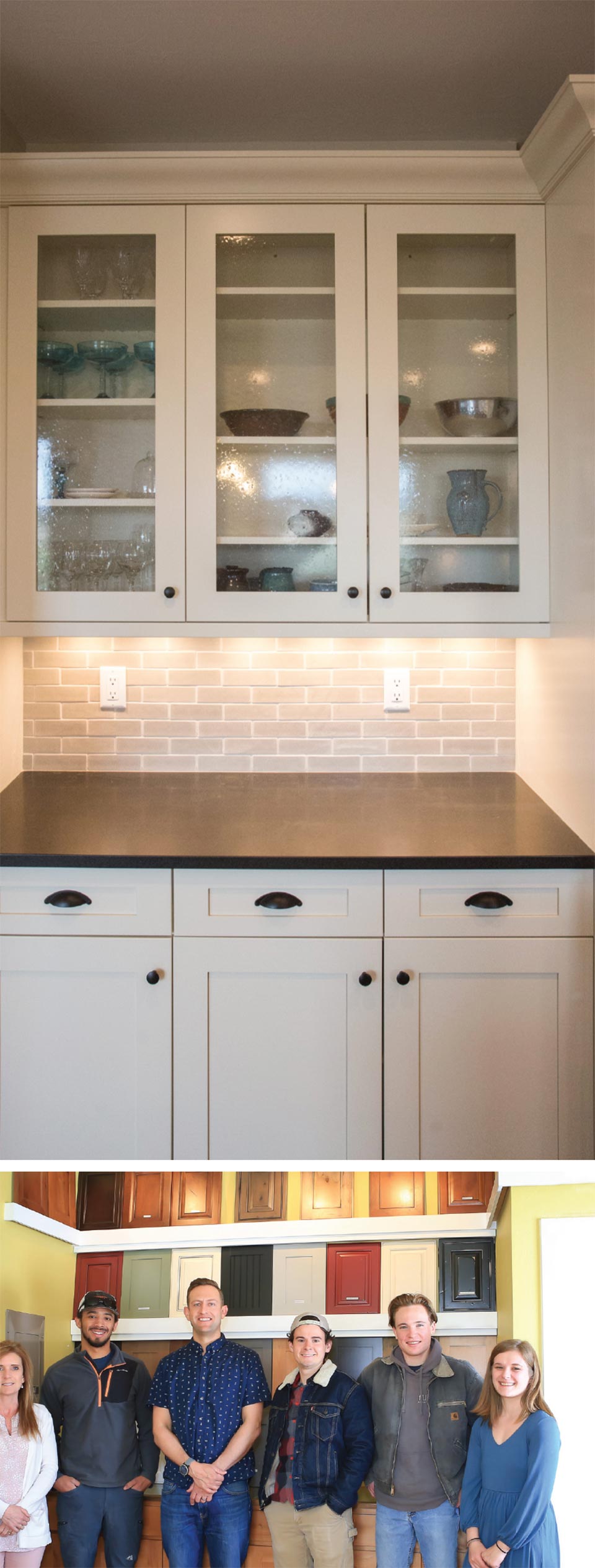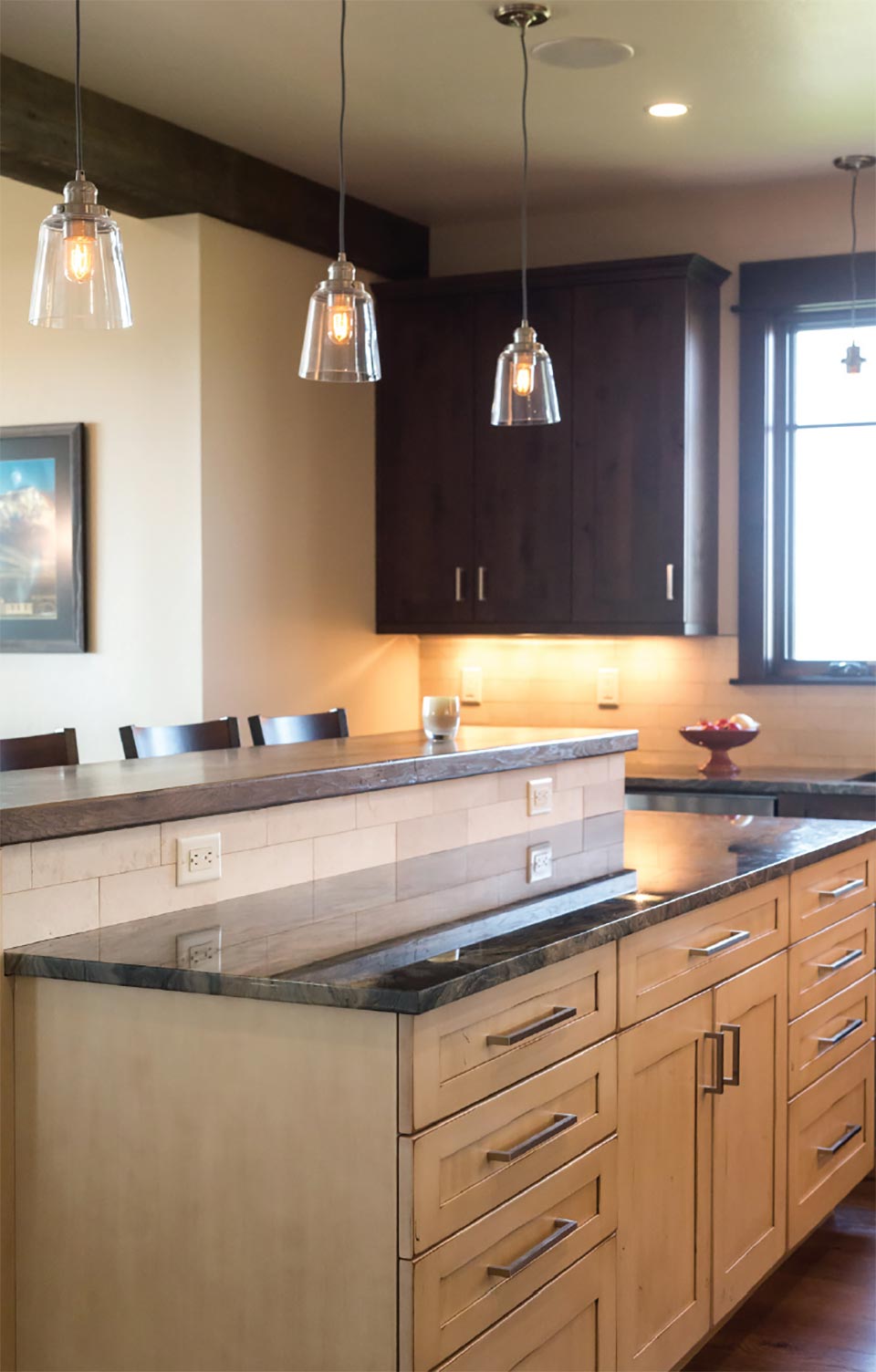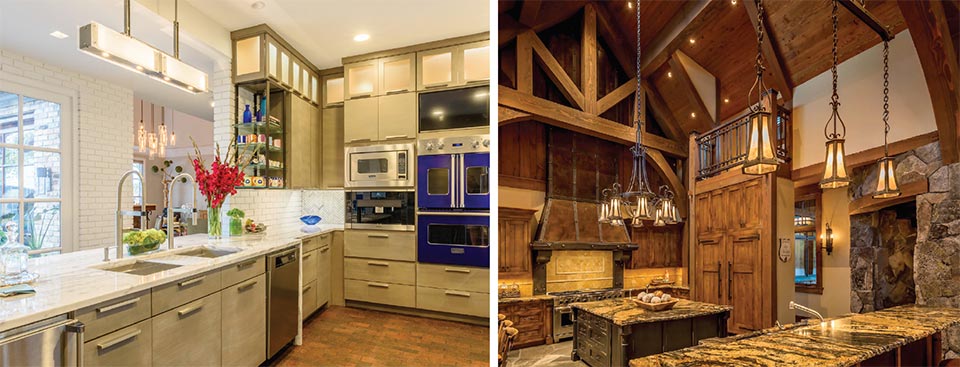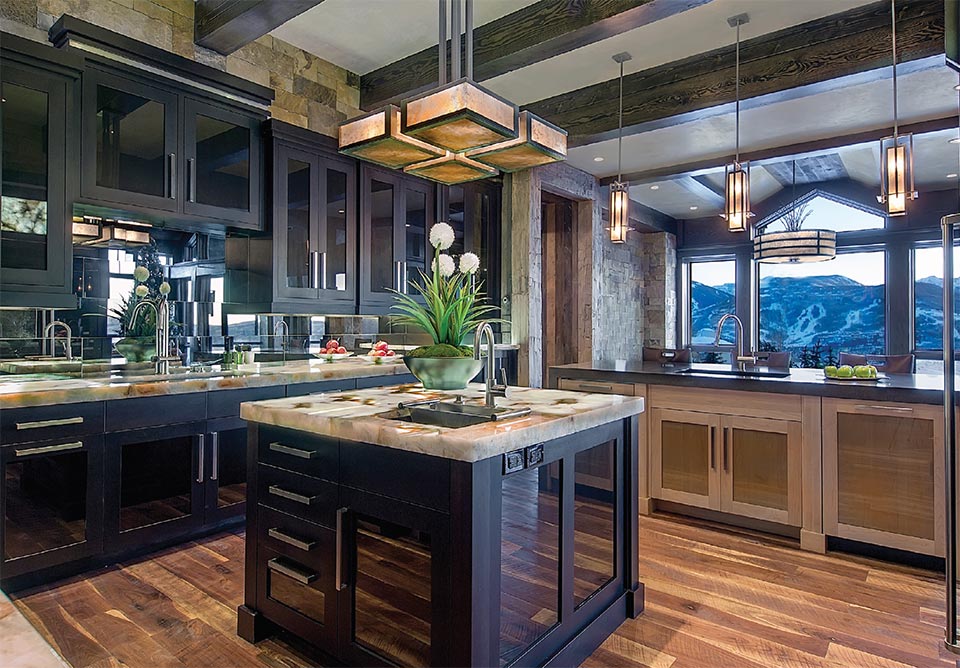Piecing Together The Perfect Kitchen
The kitchen is considered the heart of a home. And for good reason. A space built for cooking, eating, and conversing, the kitchen sustains families by providing a spot for daily connection. It’s the first place we connect in the morning, often the first place we come to decompress after work, and it sees many-an-evening filled with homework, good smells, toasts, and entertaining. In many ways, the kitchen binds families together, and, as we learned from our kitchen specialists, it does the same for homes.
Melding Styles
Studio Como
Diving into the Montana design scene, Studio Como recently opened its doors in Bozeman’s hip Cannery District. The custom cabinetry and furniture design studio is the brainchild of Brad Fentress, who began the company in an industrial neighborhood in Denver. Fentress and his team meld European practicality with mountain-inspired design to create beautiful, functional spaces rooted in the Mountain West. “We have started working a lot with the local design community and we are really excited to be involved with some excellent projects,” says Fentress, who has overseen the development of the Bozeman studio. “I continue to be amazed at the level of architecture, design, and construction talent that exists in this region.”
Location matters. Although Studio Como is known for the international style that inspires their designs, the combination of that style with local tastes makes their final products truly customized.
“Our particular area of expertise is contemporary kitchen design using a mix of both European and local components. European cabinetry systems deliver high levels of precision, unique design elements and materials, and innovative features that deliver incredible functionality,” says Fentress. His Bozeman-based team adds local materials, innovative lighting systems, and personal attention to bring the best of European design to Montana.
“Our particular area of expertise is contemporary kitchen design using a mix of both European and local components. European cabinetry systems deliver high levels of precision, unique design elements and materials, and innovative features that deliver incredible functionality.”
–Brad Fentress
Studio Como uses cabinetry from Poliform, one of the world’s most respected brands. Using a well-known manufacturer guarantees that orders will be predictable, reliable, and accurate. Every piece is built-to-order for the clients; the manufacturers’ catalogs of finishes and accessories are just a starting point. “No two kitchens look the same for our clients due to the creativity of the design team,” says Fentress. He notes that materials like local stone or wood can be integrated into kitchen designs, creating a perfectly blended European/American West flare.
In many ways, Studio Como lives in the best of both worlds. Fentress describes a display kitchen in the Bozeman showroom that features reclaimed wood fronts mounted on European cabinetry boxes along with Colorado-sourced marble countertops. This kitchen is the perfect example of a European manufactured kitchen fitting into a western home.
And then there’s the furniture. Fentress has a passion for well-made furnishings, which have their place in every kitchen design. “I believe the European look is something that is highly subjective. Many years ago, if you asked someone to describe an Italian sofa, they would say it was low, uncomfortable, upholstered in white leather with shiny chrome feet,” he says. “We have been in business for over 15 years and have never sold a white leather sofa.”
Rather than trendy aesthetics, European design focuses on the quality of materials and design that lasts a lifetime. “European furniture is made by world-class designers who understand comfort, materiality, and the importance of flawlessly executing the smallest details.” He notes that his Rocky Mountain work integrates neutral color palettes, wood, stone, and blackened metal bases into these designs.
Want to see the marriage of European and mountain design for yourself? In addition to the Studio Como showroom at the Cannery, this fall you will also be able to visit the Studio Como condo in Bozeman. “I immediately fell in love with the architecture and location,” says Fentress, who bought the condo in part due to its proximity to one of his favorite coffee shops. “Our condo will be completely furnished with all of our cabinetry, furniture, lighting, rugs, and accessories and will be available for our clients and design partners to use.” Go see it!
Personal Connection
with Ferguson
When you think of appliances, the words “cold,” “hard,” and “utilitarian” may come to mind. Finding the right installation for a space evokes equally concerning adjectives including “expensive,” “confusing,” and, most likely, “overwhelming.” Shopping for stoves, refrigerators, or dishwashers typically involves overstocked showrooms and conflicting online reviews. The process can be painful.
Not with Ferguson Bath, Kitchen & Lighting Gallery. The national company has invested a great deal of time and effort in providing top-notch customer service and knowledgeable local salespeople to make appliance shopping more enjoyable, resulting in a sense of ease during the entire process.
“We take a lot of pride in our associates and believe that they set us apart from our competition. Every hire in the company undergoes extensive training to understand what Ferguson does, how we do business, and how we create personal connections within each market,” says Montana area showroom manager Emily Krieger.
“Everything we do is aimed toward the client’s best interest. We do everything from lighting to faucet options with a big focus on appliances. Most of our conversations start with the question: ‘How do you like to cook?’”
–Emily Krieger
Born and raised in Montana, Krieger has been with Ferguson for 11 years, ever since her graduation from the business program at Montana State University Billings. “It’s such a great company to work for. We may be based out of Virginia but in Montana we form local partnerships with the building and design community.”
With showrooms in Billings, Bozeman, and Kalispell, Ferguson leverages those local connections to prioritize personal experience with each of their clients. They work alongside builders and designers to help fill a space with exactly the pieces a homeowner needs. “Everything we do is aimed toward the client’s best interest,” says Krieger, noting that there is a lot of space for personalization in the kitchen world. “We do everything from lighting to faucet and sink options, with a big focus on appliances. Most of our conversations start with the question: ‘How do you like to cook?’”
Sometimes a client will come in wanting to see an expansive range but his or her cooking needs might be more suited to a less complicated stovetop. Just one face-to-face conversation will help the team determine what kinds of cooking the kitchen will support, and which areas of the design they can best customize. Therein lies the value of the team: personal, real-time connection.
“The Internet has created a more savvy consumer who is able to do some research before they enter our showroom. Once here, our staff continues the process of educating the customer,” says Krieger. “Our showroom consultants live and breathe these products; they’ve been trained by manufacturers and are a reliable resource for our clients.”
Each of the Ferguson showrooms is spacious and filled with dozens of different brands in their inventory. Krieger says narrowing down the options is one of the greatest challenges for new clients. After gathering some ideas on taste, the Ferguson crew encourages clients to set up an appointment with a showroom consultant to pinpoint exactly which products will best suit their needs.
“We like to have about two hours of uninterrupted time when we can focus on the customer’s selections. We will often re-visit the selections until the customer is confident with the purchase,” says Krieger. After that appointment, clients are presented with a portfolio as a reminder of all that was discussed as well as which selections might be the best fit for their projects.
Once the client has taken time to make their selections, Ferguson will help facilitate delivery, coordination with cabinet installation, and follow-up. “Our goal is to provide the best customer experience possible. That includes constant education on our part. The process is streamlined for each individual so they will be confident that when they work with us it will all go as smoothly as possible.”
After years of success stories, the case has been made for the impact of Ferguson’s personal touch, making the process of selecting appliances seem not quite so cold.
From Transitions to the Transitional
Futura Kitchen Cabinetry
Change can come in all shapes and sizes, and there’s something to be said for people and businesses that handle transitions well and take advantage of the opportunities necessitated by change. In 1992, Bob Beitman found his way to Bozeman to work for Earnst, a cabinetry contractor. Bouncing between Colorado, Utah, and Idaho, the Billings native had always wanted to return to Montana. Four years later, Earnst went out of business. Bob, out of work, had to reinvent himself and established what would become one of the Gallatin Valley’s thriving family cabinetry businesses.
“Futura originally started in a 32-foot trailer,” says Bob’s son, Trevor Beitman. “My dad would pull it with his truck to job sites to meet with contractors. He had four kitchen displays in the back of the trailer and became a fast favorite for contractors because they never had to leave their sites to design cabinetry. We maintain business relationships with a lot of those original contractors today.”
Now, however, Futura no longer bases itself out of a trailer. The Bozeman-based business employs four designers and operates with a handful of different suppliers. The family business has surfed the booms and busts of the Bozeman construction industry throughout the past 20 years, and continues to grow alongside the area’s population.
“We’ve really never had a down year,” says Beitman, noting that the business experienced and weathered a large clientele shift in the 2008 market crash. “But we’re constantly adjusting to the needs of our environment. There’s been a big transition away from spec to pre-purchased homes, which means that we get to interact with our clientele a lot more. That part is really fun.”
“We work to stay on the forefront of technology so we can bring life-like design renderings to clients and make real-time modifications with them,” says Beitman. “We have a big screen in our office that allows them to sit with us and be a part of the decision-making. It’s so fun to show them the design. Their eyes light up and they get so excited.”
–Trevor Beitman
In addition to cabinet design, the team loves the connection to the clientele. They work with builders and architects throughout the drafting process, making selections and sifting through layouts. They’ve taken advantage of drafting technology that allows users to experience a design in 3D and make comprehensive changes in real time.
“We work to stay on the forefront of technology so we can bring life- like design renderings to clients and make real-time modifications with them,” says Beitman. “We have a big screen in our office that allows them to sit with us and be a part of the decision-making. It’s so fun to show them the design. Their eyes light up and they get so excited.”
Technology isn’t the only thing in transition. Design has also shifted in the past five years from traditional style to minimalist contemporary design. Creating clean lines and fluid design is challenging because each angle is intentional—each line exists for a reason—and it takes more planning and forethought to do it right the first time.
“You can’t come into a house and install when it’s already been framed; you have to think proactively,” says Beitman. “We work on the framing side with the builder or architect and get the dimensions exactly right. We’re one of the only non-custom suppliers that does it really well.”
With that transition to the contemporary comes a strong influence from Europe. Futura’s suppliers have product coming from places like Milan, the epicenter of European design. High-gloss materials and industrial looks rule, with lift-up cabinet doors and channel system cabinets coming straight from Italian markets to Montana kitchens.
“I love designing kitchens with a European feel,” says Beitman. “Simplicity is beautiful and challenging to create.” Futura is beginning to source its new Vero cabinet line from Bellmont that includes a channel rail system that is brand-new. They produce cabinets without knobs with boxes and slabs that induce a completely clean feel.
Tech and design are just two waves of innovation happening in the Gallatin Valley, notes Beitman. With MSU producing some of the country’s leading architects and designers, the entire industry has been influenced by a young, creative energy. Whatever the change, Futura is tuned in and, like his father, Trevor Beitman and his team are ready to transition to whatever is next.
Transformative Lighting
with Hammerton
Utah-based Hammerton has watched the evolution of the kitchen space from a front-row seat. Two decades ago, the custom lighting manufacturer put itself on the map by building rustic pinecone-laden steel chandeliers for luxury ski homes going up across the Intermountain West. But the lighting industry has changed dramatically since that era, and Hammerton has been on the forefront of this transformation. Today the company’s work emphasizes contemporary designs, artisan glass materials, and LED—all designed and handcrafted in their 50,000-square-foot Salt Lake City facility.
Hammerton founder and VP of Design Levi Wilson has unique insights on the paradigm shift in kitchen lighting here in the West. “The kitchen has literally become the ‘heart of the home,’” says Wilson, noting the growing popularity of open floor plans and custom design. “So a kitchen lighting plan is no longer just about function. Fixtures need to integrate with the overall interior design and help connect adjacent spaces. They must be beautiful and visually engaging, as well as functional.”
“a small space with a visually engaging lighting plan will be far more livable and enjoyable than a large space that lacks the same attention.”
–Levi Wilson
Getting kitchen lighting right, as Wilson explains, involves several considerations that are frequently overlooked. First, there is the issue of scale and proportion. “Today’s kitchens are larger than ever, but most off-the-shelf fixtures are way too small for these spaces,” says Wilson. “All too often we see massively scaled kitchen islands with tiny pendant lights floating overhead. That’s a total missed opportunity for elevating the overall kitchen design. At Hammerton, we’re not afraid of bold fixtures that make a statement and appropriately fill a space.”
Lighting materials and finishes provide a means of extending or integrating design elements across an open kitchen plan. But rather than repeating the same fixture style throughout, Wilson recommends a more inspired approach. “For large, multi-use areas, we typically recommend a series of unique lighting designs that each stand on their own but collectively nod to particular textures, colors, motifs, or other elements of the interior plan,” says Wilson. “That’s vastly more thoughtful and visually intriguing than repeating identical fixtures throughout a space.”
Also overlooked is the height at which lights are hung. Historically, the standard rule of thumb positions ceiling-mounted fixtures at 30” above a kitchen surface or sink, but an open kitchen often dictates otherwise. “It’s important to consider the overall space design before finalizing height,” Wilson explains. “Hanging fixtures too low can impact the visual flow between spaces, and also obscure scenic window views.”
Ultimately, a successful kitchen design requires planning ahead and giving the same thought to lighting as the rest of the space. “Particularly with high-end projects, the biggest mistake is not thinking about lighting until construction is well underway,” says Wilson. “When homeowners spend big dollars on custom cabinetry, luxury appliances, and the like, and then neglect to give similar consideration to lighting, it shows in a big way.”
“Decorative lighting is basically jewelry for the home,” adds Wilson. “So a small space with a visually engaging lighting plan will be far more livable and enjoyable than a large space that lacks the same attention.”

